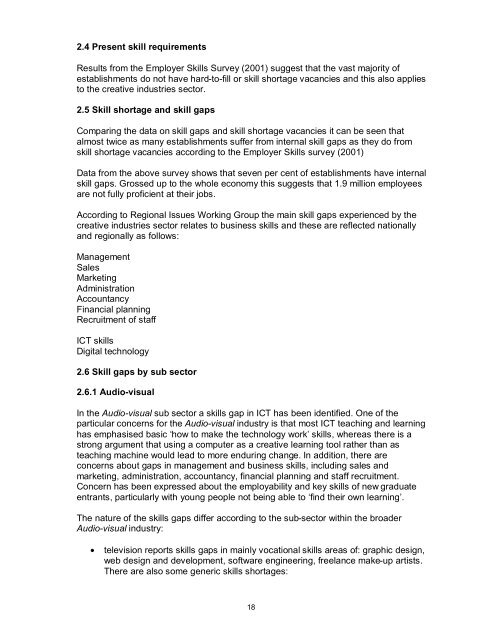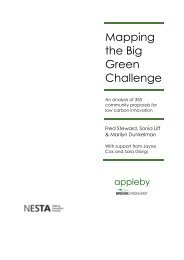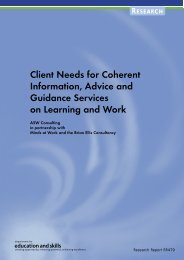An Introduction to the Creative Industries Sector - The Skills ...
An Introduction to the Creative Industries Sector - The Skills ...
An Introduction to the Creative Industries Sector - The Skills ...
Create successful ePaper yourself
Turn your PDF publications into a flip-book with our unique Google optimized e-Paper software.
2.4 Present skill requirementsResults from <strong>the</strong> Employer <strong>Skills</strong> Survey (2001) suggest that <strong>the</strong> vast majority ofestablishments do not have hard-<strong>to</strong>-fill or skill shortage vacancies and this also applies<strong>to</strong> <strong>the</strong> creative industries sec<strong>to</strong>r.2.5 Skill shortage and skill gapsComparing <strong>the</strong> data on skill gaps and skill shortage vacancies it can be seen thatalmost twice as many establishments suffer from internal skill gaps as <strong>the</strong>y do fromskill shortage vacancies according <strong>to</strong> <strong>the</strong> Employer <strong>Skills</strong> survey (2001)Data from <strong>the</strong> above survey shows that seven per cent of establishments have internalskill gaps. Grossed up <strong>to</strong> <strong>the</strong> whole economy this suggests that 1.9 million employeesare not fully proficient at <strong>the</strong>ir jobs.According <strong>to</strong> Regional Issues Working Group <strong>the</strong> main skill gaps experienced by <strong>the</strong>creative industries sec<strong>to</strong>r relates <strong>to</strong> business skills and <strong>the</strong>se are reflected nationallyand regionally as follows:ManagementSalesMarketingAdministrationAccountancyFinancial planningRecruitment of staffICT skillsDigital technology2.6 Skill gaps by sub sec<strong>to</strong>r2.6.1 Audio-visualIn <strong>the</strong> Audio-visual sub sec<strong>to</strong>r a skills gap in ICT has been identified. One of <strong>the</strong>particular concerns for <strong>the</strong> Audio-visual industry is that most ICT teaching and learninghas emphasised basic ‘how <strong>to</strong> make <strong>the</strong> technology work’ skills, whereas <strong>the</strong>re is astrong argument that using a computer as a creative learning <strong>to</strong>ol ra<strong>the</strong>r than asteaching machine would lead <strong>to</strong> more enduring change. In addition, <strong>the</strong>re areconcerns about gaps in management and business skills, including sales andmarketing, administration, accountancy, financial planning and staff recruitment.Concern has been expressed about <strong>the</strong> employability and key skills of new graduateentrants, particularly with young people not being able <strong>to</strong> ‘find <strong>the</strong>ir own learning’.<strong>The</strong> nature of <strong>the</strong> skills gaps differ according <strong>to</strong> <strong>the</strong> sub-sec<strong>to</strong>r within <strong>the</strong> broaderAudio-visual industry:• television reports skills gaps in mainly vocational skills areas of: graphic design,web design and development, software engineering, freelance make-up artists.<strong>The</strong>re are also some generic skills shortages:18











